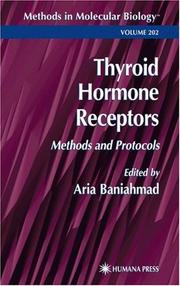| Listing 1 - 2 of 2 |
Sort by
|

ISBN: 1280821361 9786610821365 1592591744 0896039951 Year: 2002 Publisher: Totowa, NJ : Humana Press : Imprint: Humana,
Abstract | Keywords | Export | Availability | Bookmark
 Loading...
Loading...Choose an application
- Reference Manager
- EndNote
- RefWorks (Direct export to RefWorks)
Because thyroid hormone receptors (TRs) are important regulators of a large number of biological processes-ranging from brain development to control of vision in vertebrates-abnormal functioning of these receptors can have serious medical consequences. In Thyroid Hormone Receptors: Methods and Protocols, a panel of outstanding investigators surveys and explains the major cutting-edge methods used in TR research and their practical experimental details. Described in step-by-step detail to ensure robust experimental results, the techniques presented cover a wide variety of key areas, including TRs in development and generation of knockout (mouse and Xenopus), transcriptional regulation by TRs in both cell-free systems and living cells, and TR mutant analysis of patients. Additional methods provide powerful tools for the isolation of TR-regulated protein complexes, for the study of blood cell differentiation through the oncogene v-erbA, and for target gene analysis in the brain. Microarray chip methods are also presented for analyzing the organs of transgenic mice to identify target genes in the liver. Each protocol has been developed by a hands-on expert and contains full explanatory notes, troubleshooting tips, and helpful comments on avoiding pitfalls. Broad ranging and highly practical, Thyroid Hormone Receptors: Methods and Protocols offers endocrinologists, geneticists, biochemists, and research physicians a comprehensive collection of powerful methods useful not only for all major areas of TR biology and analysis, but also for nuclear hormone receptors in general.
Endocrinology. --- Internal medicine --- Hormones
Book
ISBN: 1280505338 600000446X 1601294336 9786610505333 Year: 2002 Publisher: Amsterdam ; Washington, DC : IOS Press,
Abstract | Keywords | Export | Availability | Bookmark
 Loading...
Loading...Choose an application
- Reference Manager
- EndNote
- RefWorks (Direct export to RefWorks)
Why do men get more heart disease than women? Recent global trends in heart disease show that traditional coronary risk factors, such as elevated blood pressure and cholesterol are poor candidates in explaining the gender gap in heart disease. Changes in these risk factors also cannot explain the recent cardiovascular disease epidemic among middle-aged men in Eastern Europe. This book focuses on environmental, behavioural, and psychosocial variables, as well as new risk factors of a biological nature in an attempt to understand the gender gap in heart disease. It combines perspectives from num
Coronary heart disease --- Stress (Physiology) --- Stress (Psychology) --- Environmental aspects. --- Epidemiology. --- Sex differences.
| Listing 1 - 2 of 2 |
Sort by
|

 Search
Search Feedback
Feedback About UniCat
About UniCat  Help
Help News
News